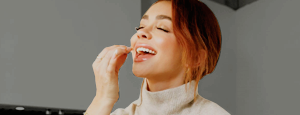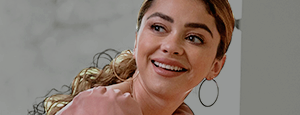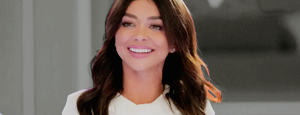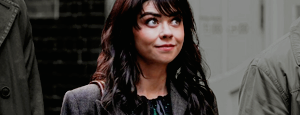By her count, Sarah Hyland, 28, has had about 16 surgeries. Six in the past 16 months or so—including a second kidney transplant, laparoscopic surgery for endometriosis, and surgery to correct an abdominal hernia.
Her first kidney transplant from 2012 was already public knowledge—her dad gave her one of his when she was 21. But much of the rest of her health history is not. After a few years of occasionally referencing medical issues without going into specifics, she is ready to share more. I’m in Los Angeles to interview her about it.
We’re tucked away in a back booth on the patio of the Polo Lounge. Magenta bougainvillea dot the space, but tree trunks wrapped in fairy lights and a slight bite in the air hint at autumn. Many of the Polo Lounge’s diners are familiar enough to make my brain itch. Hyland fits right in, having become a household name years ago thanks to her role as Haley Dunphy on ABC’s Modern Family, the award-winning ensemble comedy that has been running for nearly a decade.
Our conversation, in many ways, is like any other conversation in which a writer (me) interviews a famous 20-something (her) for a celebrity profile (this one). We go to a fancy restaurant for an hour, and talk about the usual things that you’d expect from a story like this: career, love, family, body image, workouts, beauty routines. You know the drill—those mundane (yet somehow fascinating!) details of daily life for a normal celebrity with millions of Instagram followers.
In some important ways, though, this conversation is different. For Hyland, it is impossible to discuss the standard celebrity profile details without also discussing her lifetime of living with chronic illness, which has colored every facet of her life.
As we talk, I keep noticing Hyland’s enormous eyes, framed in a fan of long, glorious lashes. Her large gold glasses magnify them, making them look even bigger. She reminds me of a woodland creature that has evolved to peak cuteness as a survival mechanism. I imagine David Attenborough narrating a nature show about life and death in an unforgiving landscape.
But being cute as hell and strong as hell aren’t mutually exclusive, an obvious fact that resonates more deeply the longer we talk. Hyland’s body has put her through the wringer, forcing her to confront her own lack of control and adjust her goals, expectations, relationships, and self-image to make space for her medical needs. Throughout it all, she has exhibited near-superhuman strength and perseverance. And yet, as Hyland points out, something she wishes more people would understand: “I’m just a human being.”
Here’s what you may already know.
Hyland was born with kidney dysplasia, which essentially means her kidneys didn’t develop normally when she was in the womb. Kidney dysplasia causes your kidneys—those critical bean-shaped organs—to grow cysts. Those cysts can disrupt the kidneys from doing their job of filtering waste products out of your blood.
Some people with only one dysplastic kidney go on to have few, if any, health problems related to the condition. But Hyland’s kidney dysplasia was so severe that she went into kidney failure. Eventually, she needed a transplant. Her father donated one of his.
To the public, that was pretty much it: Hyland needed a kidney, her dad gave her one, case closed.
But here is what you don’t know.
In October 2016, Hyland’s body began to reject the kidney her father donated to save her life. “When you have an organ transplant, it’s basically a foreign thing in your body,” she explains. “Your immune system will want to attack it and be like, ‘What is this? This is not supposed to be here.’” She was overcome with fatigue, and experienced frequent fevers and infections. A visit to the doctor revealed that her level of the waste product creatinine, which your kidneys are meant to remove from your blood, was higher than it had been before the transplant.
“We did all of these tests and all of these treatments to try and save the kidney,” Hyland says. She shuttled in and out of the hospital for months. “Christmas break, New Year’s, Thanksgiving, my birthday, all of that spent in the hospital,” she says. None of the treatments took. Her medical team compared the transplanted kidney to a home that had caught on fire. As Hyland notes, “You can’t un-burn a house.”
On Valentine’s Day of 2017, Hyland went on dialysis, which is when a machine filters blood for you because your kidneys can’t. It was her first time on dialysis. This required implanting a device called a port into her chest to connect to the dialysis machine. The chest port was visible underneath Hyland’s skin, leading a lot of people to think she had an injury like a broken collar bone. Nope. Just the port. “I called it my tube titty,” Hyland says.
Dialysis was a life-saving slog; Hyland was hooked up to a machine three times a week for four hours per session. Her weight dropped, prompting invasive public speculation. She got sciatica (severe pain radiating from the lower back). Her face swelled up due to immunosuppressant drugs, and fluid retention caused her blood pressure to spike enough to damage her vision, which already wasn’t great.
Hyland responded to this new medical dependence by exerting her independence wherever she possibly could, such as by fitting in dialysis around her shooting schedule. Hence her choosing the dialysis center closest to the Modern Family set. “That’s why I’m so independent,” she says. “In some areas of my life, I literally have no choice but to be dependent. I’ve been going through this for 28 years, and I still am learning how to let go of control and how to be patient.”
Dialysis wasn’t enough to rehabilitate Hyland’s health. The transplanted kidney also had to come out, and she would need another transplant. In May 2017, doctors removed the organ. A few months later, Hyland found out her younger brother, Ian, was a match for transplant number two. He was ready and willing to donate an organ to his big sister.
“When Sarah first told me that she would need a second transplant, the initial wave of fear was washed over by a sense of resolution,” Ian Hyland, 23, told me in an email. “I only cared about Sarah knowing that I had her back and that she was going to be OK.” Finding out he was a match made Ian feel like he could breathe again for the first time in months, he says, adding, “I’m about as stubborn as Sarah once I’ve made up my mind. I probably would have insisted on donating even if I wasn’t a match.”
The potential of a second kidney transplant was promising for Hyland’s physical health. But the emotional trauma from the first rejection and fear that it would happen again was overwhelming, and detrimental to her mental health.
“I was very depressed,” she says. “When a family member gives you a second chance at life, and it fails, it almost feels like it’s your fault. It’s not. But it does.” As someone who self-identifies as a control freak and micromanager, she says she felt completely helpless. “For a long time, I was contemplating suicide, because I didn’t want to fail my little brother like I failed my dad,” she says. She was afraid of adding another painful chapter to her book of lifelong health struggles, and anxious about feeling like she would be a burden to her loved ones, even as they insisted that she was not. “I had gone through [my whole life] of always being a burden, of always having to be looked after, having to be cared for,” she says, explaining her thought process during this dark time.
Talking about her suicidal thoughts with someone close to her helped, Hyland says. She encourages others going through a hard time to be open about their feelings with their own support networks. “It’s not shameful,” she says. “For anybody that wants to reach out to somebody but doesn’t really know how because they’re too proud or they think that they’ll be looked upon as weak, it’s not a shameful thing to say. It’s not a shameful thing to share.”
If people do try to shame you about anything regarding your health, physical or mental, or if they drop you from their lives after you share your health struggles, well, Hyland’s been there, too. “If someone acts like that, feel sorry for them that they can’t be a compassionate, loving human being,” she says, quickly allowing for the possibility that the other person may be going through stuff of their own. Still. “You don’t need that type of person in your life. I’ve experienced that, and it’s heartbreaking,” she says. “But as soon as you realize their true colors and what type of person they really are, it’s … a very freeing sensation.”
Hyland points to a few things that helped her cope throughout her experiences. Like her dogs, for example. They sense when she’s sick and needs some extra love, she tells me. Humans, Hyland and I agree, do not deserve dogs, and dogs, we also agree, deserve to run the world. Her job has also been a source of strength. “My work is my therapy. I wouldn’t be here if it wasn’t for my work,” she says. And, of course, the support of her family. “I’m so grateful for my entire family, especially my brother, especially my dad, especially my mom,” she says.
Hyland had her second kidney transplant, donated from her brother, in September 2017. A year and change later, and they’re both doing well.
“The recovery period is not easy, nor is it something anyone can fully prepare you for,” Ian says. There was of course pain, discomfort, and some trepidation throughout the entire donation process, with some of those physical symptoms lasting a couple of months afterwards. But he doesn’t regret his choice. “The entire notion of taking an organ outside of your body is, at best, intimidating,” he says. “But if it saves the life of someone you care about, anything is worth it.”
Sarah, meanwhile, is still dealing with the aftereffects of the transplant, both large and small, some of which will last forever. “The thing that I miss most is grapefruit,” she says. “I fucking love grapefruit.” Sarah Hyland, I learn, is a woman who will wax poetic about the perfect spoonful of citrus flesh. But grapefruit can interfere with the immunosuppressants she’s on to prevent her body from rejecting her new kidney. “I will be on those medications for the rest of my life, so no grapefruit for the rest of my life,” she explains. “Damn it. I shouldn’t have said that. Now everybody out there knows how to poison me.”
In a sense, the second time post-transplant is both easier and harder than the first, she says. Now she at least knows more of what to expect, like the medication-induced increase in appetite and cravings for sweets that she experienced. “I started eating eight Milky Way bars and an angel food pineapple cake a day,” she says of the period after the first transplant. “Literally wouldn’t even take it out of the pan.”
She’s still coming to terms with how her new kidney has changed her body’s appearance, too. “When they do a kidney transplant, they connect the new kidney to your old kidneys in front,” she says. From Hyland’s perspective, this creates the effect of making her lower abdomen protrude a bit. “I call it my KUPA: kidney upper pussy area. Always have. Will forever.” She tries to make light of it, but admits that it can make her feel self-conscious. “It’s this bittersweet moment of, ‘Oh my gosh. I have new life,’ but then also being an actress and being held up to this sort of pedestal of how you’re supposed to look,” she says. So, yeah, KUPA can throw her for a loop. “Sometimes I have complete meltdowns in the middle of fittings,” she says. “Being like, ‘KUPA will show. I really want to wear this dress and you can’t hide it.’”
While her recovery from the second transplant has been fairly smooth, Hyland unfortunately has had other health conditions to contend with in the meantime. She also has endometriosis, a very painful chronic reproductive health condition. And on top of that, somewhere along the way, Hyland had developed an abdominal hernia, where internal tissue pushes through abdominal muscles. “I was still in severe pain after the transplant, and that was due to the endo and the hernia,” she says.
In spring of 2018, after she was sufficiently recovered from her second transplant, Hyland had two surgeries within a few weeks of each other: a laparoscopic surgery for her endometriosis, and her hernia repair surgery. She says the surgeries were supposed to happen at the same time, but then things got a bit complicated. “I was in so much pain from the hernia that I had a heating pack on, and because I have so many scars down there, I’m numb, and I didn’t realize, and I got a [really bad] burn,” she says. “It was this huge blister.”
She says her doctors advised that it wasn’t safe to do the hernia repair until the burn healed. “So, we did the endometriosis surgery first, and then a couple weeks later, we did [the other one].”
There’s debate about what exactly causes endometriosis. Experts aren’t sure if it happens when the tissue that lines the uterus bubbles up on other organs, or if the tissue is similar to this lining but different in that it can churn out and feed on its own estrogen. What’s clear is that it’s often debilitating.
Laparoscopic surgery offers the best chance of getting rid of lesions that cause endometriosis’ characteristic agony, although in some cases (including Hyland’s) one surgery isn’t enough to get rid of all the lesions that cause pain. Even after the surgery, she still deals with the painful condition. “[This week] I’ve had a flare-up with my endo,” she says. “It has been hard to stand up straight, let alone work.” Endometriosis causes Hyland searing, cramping pain in her lower abdomen that also radiates into her back. “The fetal position helps a lot,” she says with the resigned attitude of someone who knows because they’ve contorted themselves into every possible pose when seeking a reprieve from the pain.
She hopes to have another surgery to target the remaining endometriosis lesions sometime in the future, but isn’t eager to rush into it—which makes sense, given how much time she’s already spent in the hospital and in recovery. It also doesn’t help that the recovery from the first laparoscopic surgery was almost unbearable, Hyland says. Laparoscopic surgery is done through small abdominal incisions, so in order to have the space in your abdomen, doctors basically pump you full of gas. After the surgery, doctors get rid of as much of the gas as possible, but whatever remains navigates through your chest and back trying to escape. “Laparoscopic [surgery is] one of the most painful things I’ve ever been through in my life,” she says. Given the number of surgeries Hyland has had, she’s certainly able to form a strong opinion on this one.
If you follow Hyland on Instagram, you’ve probably heard about her uterus at some point or another. She often talks about her health on her social media accounts, including her experiences dealing with endometriosis. We talk about a recent Instagram Story she posted that featured two important items in her endometriosis-fighting toolkit: a heating pad and pie. (“But be careful with heating pads,” she says, for obvious reasons.)
Then I mention a different Instagram Story, this one saved to her Story Highlights instead of forever lost to the digital ether. In the video, Hyland sits in her car. She’s wearing a pretty white dress. And, she tells viewers, she just got her period. “I don’t care if that was too much information,” she adds.
Hyland is fed up with the stigma surrounding bodily functions like menstruation, which is (obviously) nothing to be ashamed of. She remembers feeling differently when she was younger. “As an adult I just want to call that out and bring kind of a joy to it, in a sense. It’s important to talk about and laugh at those situations,” she says. “It’s breaking the judgment with humor before you’re criticized.”
On a more serious note, she’s also tired of people—and doctors in particular—not taking women’s pain seriously, especially when it comes to endometriosis. “It affects so many women, and so many women go undiagnosed and just think that they’re having horrible cramps and they’re being dramatic because that’s what they’re told,” she says. “A lot of doctors think that when you’re in pain, you’re not really in pain, that you’re just being dramatic, that it’s all happening in your head. I’ve been through that. I’ve dealt with doctors like that. Those doctors can go to hell.” So yeah, she’s outspoken about this stuff.
She’s also no stranger to judgment or criticism. That’s what happens when you’ve been in the public eye since before age 10 and have racked up roughly six million followers on Instagram, give or take. When I mention this figure, she looks a little shocked. “That number doesn’t seem like a real number to me because it’s strange to think about,” she says. “So, a lot of the times when I post things, like I got my period in my white dress, I forget that it’s going out to that many people. I’m just thinking, ‘Oh, my friends will think this is funny!’”
Luckily, most of those six million people are devoted fans. “They’re lovely, amazing human beings,” Hyland says. “If someone says a remark that’s mean or ignorant or something that shouldn’t be asked because it’s already been answered in the past, [my fans] go to town. They’re my warriors.”
It’s a fitting description, as many of Hyland’s followers, it seems, are fighting their own health issues, often sharing them in her direct messages. (Yes, she reads them sometimes.)
“There’s a lot of amazing, brave women and men out there,” she says. “It’s mainly women that reach out to me a lot, especially about endometriosis and kidney failure.”
While she hates that other people are in similar situations, she loves the reinforcement of realizing she’s not alone, especially when she’s having the kind of week where it seems as though every person around her is the picture of perfect health.
Responding to each message she receives would take up a lot of time that Hyland doesn’t have. So, to those supporters flooding her DMs and comments, she wants to share a few things that she’s found helpful, in the hope that it might be useful to others:
- “There’s no such thing as a stupid question. Especially when it comes to your health and your body.”
- “Being a well-informed patient is the best thing you can do. As someone who’s sick, that’s the only thing you’re actually really in control of.”
- “It’s really important to feel. There are times to swallow it and just continue working, but if you’re home and if you’re with your boyfriend, your girlfriend, your mom, your dog, your goldfish and you feel like crying, just cry.”
- “Surround yourself with good people. Having a very strong support system is really, really, really important. And even when you have a strong support system, you have to utilize it.”
About that support system. If you look through the comments on Hyland’s Instagram posts often enough, you’ll start to notice a consistently encouraging presence rallying behind her, telling her she’s beautiful, and dispatching witty comebacks to trolls when necessary. Yes, it’s time to talk about Wells.
When I mention Hyland’s boyfriend, her energy takes on a slightly effervescent thrum, unfurling like a cat that’s found its perfect patch of sunlight. The two started talking when Hyland was on dialysis, she explains, about a month before her second transplant. As they flirted, she kept her health issues to herself, assuming nothing serious was going to happen. He was thousands of miles away in Nashville. “Then I started to really, really like the dude,” she says. The dude in question is Wells Adams, a radio DJ who entered the public eye via a stint on The Bachelorette. Hyland was an avid viewer.
When Adams appeared on the show in 2016, Hyland was happily in a relationship with someone else. But, as most viewers do, she judged the suitors with her friends. “I was like, ‘I really like the radio DJ,’” she says, ticking off his attributes that jumped out at her through the screen: nerd-hot, funny, dimples. “I’m a dimple person,” she says. “They’ll get you every time.”
Once Adams was eliminated from The Bachelorette, he started playfully reviewing the series on Snapchat. Hyland’s friends pointed out to her that they were making the same very specific, very weird jokes. “Every week it was the same thing,” she says. “My girlfriends were like, ‘Oh my God, you guys are like the same person.’”
Later, when they were both single, she tweeted at him. He slid into her DMs. It’s a perfectly modern love story.
“We met each other for the first time three days before my transplant,” Hyland says. “He was texting me in the morning before I went into surgery, and we were FaceTiming the entire time I was in the hospital.”
(Quick aside here to acknowledge that the week she had her second transplant and met Adams in person for the first time was a lot, even for someone as busy as Hyland. As she describes it: “September 16th I had an [Emmy Awards] party and my first date with [Wells]. The 17th was the Emmys. The 18th I had work on Modern Family at 6 A.M. and then I went to dialysis afterwards. And then I had to be at the hospital at 4 o’clock in the morning for my transplant the next day.”)
Adams was there for her during the recovery process post-transplant. “He’s seen me at my worst,” she says. Hooked up to all sorts of wires. In such a tremendous pain medication fog that she still doesn’t remember what she said. “He was there through all of that,” she says. “I think that’s why I feel the most beautiful in his eyes, because he still finds me beautiful after seeing all that.”
The experience brought them closer pretty quickly. “It was a really intimate start to a relationship to have to go through those hurdles at the very, very, very beginning when you’re just even getting to know a person,” Hyland says. “Also, falling in love with someone before you can really be intimate. I did not believe that that was a thing, but it is.”
That, at least, is a bit different now that they’ve been together for more than a year. For Hyland, two things are key to being a good couple: “You have to have good sex, and you have to be able to fight well,” she says. “It’s funny because I’ve always been the one that communicates the most in a relationship. And now he is. I’m like, ‘Wait, I’m so confused. What is happening?’ … If we get in a fight, I’m like, ‘How am I acting like the child?’”
The two do the kind of sentimental things you would expect in a romantic comedy about a man named Wells Adams and a woman named Sarah Hyland, like hiding cards in each others’ luggage when they’re away from each other, which is often. “We’re just very busy working. And I think that’s also what makes relationships work,” she says. “You have to have your own thing … so when you come home at the end of the day, you’re excited to see that person.”
When I ask if there was One Specific Moment where she knew that Wells Was It, she has a story for me. “I’m probably gonna get shit for this, but whatever,” she says. “We were dancing, and I had water in one hand.” She was also holding a clutch. Then…drum roll…he asked to hold her purse.
She mimics her suspicious reaction, the kind you have when your gut has been whispering that something is too good to be true. “I physically, like, retracted, and I was like, ‘What, why do you want to hold my purse?’” His response: So she could dance more comfortably. “‘I don’t know, I’m just trying to be a gentleman,'” she says, imitating him.
This may not seem huge, but Hyland says that in the past, she has been in relationships with partners who have said, verbatim, “I don’t want to be the guy holding your purse.” “I was just shocked that someone asked to hold my purse for the first time,” she says. She kept the purse, but he caught, and has kept, her heart.
It’s no wonder, then, that when I ask what Hyland would do with a free weekend, what would make that weekend perfect, it would be to return to the place where she and Adams had their first romantic getaway. “Oh, I would go up to Ojai,” she responds immediately. The small town (population: 7,582) northwest of L.A. holds a special place in her heart as the first outing she was able to take post-transplant. It provided everything she needed. “I just need food and animals and wine—in increments,” she says. “And a nice massage.” Relatable.
Ojai has the spa offerings, a big plus for Hyland, a skin-care devotee who highly recommends chilling sheet masks in the fridge before applying. (This is also where that experimentation with different beauty gadgets to cut down on her prednisone-induced facial swelling comes in.) Ojai has the renowned food and wine. There’s horseback riding out there, too. For someone whose health can often make her feel like she lacks control, horseback riding gives her the opportunity to see the world from up high and on her own terms. With a simple tug of the reins, she can steer the powerful animal underneath her: ease up, now faster, faster.
Today, Hyland is learning to trust her body again. She says she feels most comfortable and confident when she hits a personal record at the gym. “I love to weight lift. That’s my favorite thing,” she says. (Cardio, which Hyland calls “a necessary evil,” can “run itself to death” for all she cares.) She’s newly learning her way around a body that once sapped her energy (and, thanks to the endometriosis, still does on occasion). Now, lifting weights helps her drill into herself, striking untapped power with every repetition. What is setting and reaching physical training goals if not one of the ultimate forms of control over an unruly body?
Before her previous surgeries, Hyland has worked out to be as strong as possible knowing that she would lose muscle during the recovery period. Now, she says, she can exercise simply to become stronger, period. But she’s also learning to loosen her grip when necessary.
“That is a goal, to not just listen to my body more, but listen and do something about it because I tend to push myself,” she says. “I tend to burn the candle at both ends, and not just one candle, but all the candles that I possess.”
Now, if her body is telling her what it needs is rest, she tries to honor that. But she is, she emphasizes, a complete workaholic. In addition to Modern Family, she’s taking on projects like The Wedding Year, an upcoming movie she’s executive producing and starring in as a commitment-phobic photographer. Learning to balance rest and work is vital for Hyland, because she’s got a lot in store.
To put it simply, Hyland is feeling pretty good, all things considered. So far, her second transplant has been a success. “I’m stable. I’m thriving. I’m super happy with life,” she says. It doesn’t mean there aren’t inky, brambly bits of her past that hurt to touch and that have changed her irrevocably. And her endo pain is obviously still an ominous presence, sometimes more debilitating and overwhelming than other times. But Hyland is keeping on, and trying to keep everything in perspective. One day at a time.
“My name is Sarah,” she says. “I have two of the most amazing dogs in the entire world. I have the best boyfriend ever, who has the third-most amazing dog in the entire world. I have the greatest family one could ask for. I’m on a show that is absolutely unbelievable and surreal,” she says.
“Oh, and also, I was born wrong. Physically. In a way that’s not good for your body to keep going. Oh, and also, I have endometriosis. Oh, and also, I have kidney failure. Oh, and also, I’m a two-time kidney recipient. Oh, and also, I had a frickin’ hernia for almost a year that went unnoticed.”
“That list doesn’t stop,” she admits. She could go on. Instead she forges forward, as she has done, as she will continue to do. “But that list doesn’t hold me back from anything. I won’t let it.”



























